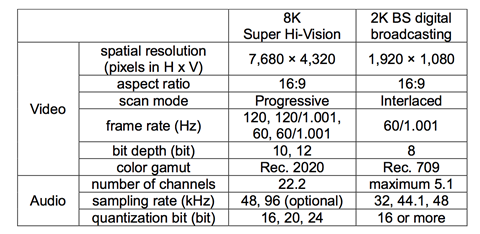ABSTRACT
This paper introduces the world’s first video and audio codec system that complies with 8K broadcasting standards and describes transmission experiments via a broadcasting satellite using this system.
8K Super Hi-Vision (8K) is a broadcasting system capable of highly realistic 8K Ultra High Definition Television (UHDTV) video and 22.2 multichannel audio.
In Japan, domestic standards for 8K broadcasting were formulated in 2014 and 8K test broadcasting began in 2016.
We have developed an 8K High Efficiency Video Coding (HEVC)/H.265 codec system that complies with the domestic standards.
In this paper, we first explain the features and a roadmap for 8K broadcasting.
We then introduce the features of the 8K HEVC/H.265 codec system developed.
Finally, we describe transmission experiments using a satellite system that is equivalent to the one that will be used in test broadcasting.
The results allowed us to confirm that the developed system provides high-quality transmission at the expected bit rate during test broadcasting.
INTRODUCTION
An 8K Super Hi-Vision (8K) broadcasting system capable of highly realistic 8K Ultra High Definition Television (UHDTV) video and 22.2 multichannel (22.2 ch) audio is currently under development.
In Japan, domestic standards for 8K broadcasting were formulated in 2014 and 8K test broadcasting using a broadcasting satellite will begin in 2016.
The standards prescribe video coding, audio coding, multiplexing and transmission schemes, and other such procedures.
Compression of video data to a transmittable bit rate while maintaining high quality is a key issue that must be addressed in order to realize 8K broadcasting.
A new video coding scheme, referred to as High Efficiency Video Coding (HEVC)/H.265 (1), was standardized in 2013.
HEVC supports 8K video formats and achieves approximately twice the compression level of the existing Advanced Video Coding (AVC)/H.264 scheme.
Its coding performance shows a particularly significant improvement relative to the previous schemes for high-resolution video such as 8K.
On the other hand, the computational cost for HEVC encoding and decoding is quite high and is reported to be more than twice that of AVC.
This makes realization of real-time HEVC processing challenging.
We have developed the world’s first 8K HEVC/H.265 real-time codec (encoder and decoder) system that complies with the domestic standards.
The system allows 22.2 ch audio coding and video/audio multiplexing, with these functions integrated into the video encoder and decoder.
The system was tested by transmission experiments using a broadcasting satellite in 2015.
In this paper, we first explain the features and a roadmap for 8K broadcasting.
We then introduce the features of the 8K HEVC/H.265 codec system.
Finally, we describe transmission experiments using a satellite system that is equivalent to the system that will be used for the test broadcasts.
8K BROADCASTING
In this section, we explain the features and a roadmap for 8K broadcasting.
8K Super Hi-Vision
8K is a TV broadcasting system designed to deliver highly realistic 8K video and 22.2 ch audio.
Table 1 shows the parameters for 8K and a current 2K digital broadcasting system using a broadcasting satellite (BS) in Japan. The 8K provides much higher fidelity than the existing broadcasting system.

The 8K video format is internationally standardized in Recommendation (Rec.) International Telecommunication Union Radiocommunications Sector (ITU-R) BT. 2020 (2).
Since the number of pixels in the horizontal direction is 7,680 pixels, it is called “8K.”
Its characteristics are higher spatial resolution, higher frame rate, higher bit depth, and wider color gamut than those of the existing broadcasting video formats.
The uncompressed bit rate for the 8K/12 bit/60 Hz format is approximately 72 Gbps.
The 22.2 ch audio format is standardized in Society of Motion Picture & Television Engineers (SMPTE) 2036-2-2008 (3).
It is characterized by a larger number of channels, increased sampling rate, and larger quantization bit.
The uncompressed bit rate for the 22.2 ch/48 kHz/24 bit format is approximately 25 Mbps.
Because of the enormous uncompressed bit rate of 8K video, compression of the video to a transmittable bit rate while maintaining high quality is a key issue for 8K broadcasting.
8K Broadcasting Roadmap
In Japan, a committee of the Ministry of Internal Affairs and Communications (MIC) presented a roadmap for 8K broadcasting in 2014.
According to the roadmap, 8K test broadcasting will begin in 2016 and 8K broadcasting is planned to begin by 2018.
























No comments yet